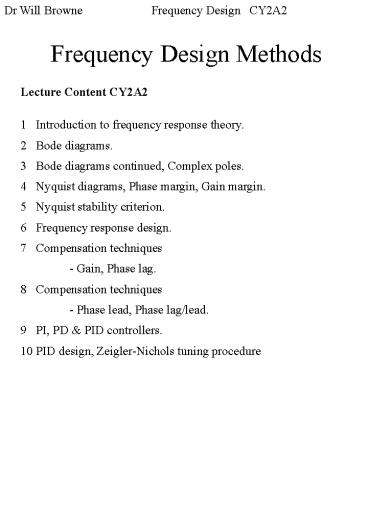Frequency Design Methods - PowerPoint PPT Presentation
1 / 12
Title:
Frequency Design Methods
Description:
3 Bode diagrams continued, Complex poles. 4 Nyquist diagrams, Phase margin, ... response function, can be displayed on an argand diagram in the form of a polar ... – PowerPoint PPT presentation
Number of Views:43
Avg rating:3.0/5.0
Title: Frequency Design Methods
1
Frequency Design Methods
Dr Will Browne Frequency Design CY2A2
Lecture Content CY2A2 1 Introduction to
frequency response theory. 2 Bode diagrams. 3
Bode diagrams continued, Complex poles. 4
Nyquist diagrams, Phase margin, Gain margin. 5
Nyquist stability criterion. 6 Frequency
response design. 7 Compensation techniques -
Gain, Phase lag. 8 Compensation techniques -
Phase lead, Phase lag/lead. 9 PI, PD PID
controllers. 10 PID design, Zeigler-Nichols
tuning procedure
2
Frequency Design Methods
References Control Systems Engineering J.
Nagrath, M. Gopal (out of print) J. Wiley
Sons Feedback Control Systems C.
Phillips, R. Harbor Prentice Hall
An Introduction To Control Systems K.
Warwick World
Scientific Control Systems
Engineering N. Nise 3rd Ed. J. Wiley
Sons ISBN 0471366013 Modern Control
Systems R. Dorf R. Bishop Addison-Wesley
Modern Control Engineering K. Ogata 3rd
Ed. Prentice-Hall ISBN 0132613891
Linear Control Systems Analysis J. DAzzo C.
Houpis and Design McGraw-Hill May also be
of interest http//www.engin.umich.edu/group/ctm/
freq/nyq.html
3
Frequency Response
P/1
Input Function Sketch Use Impulse
?(t) Transient response
Modeling Step u(t) Transient
response Steady-state error Ramp
tu(t) Steady-state error Sinusoid sin
?t Transient response Modeling
Steady-state error
f(t) t
f(t) t
f(t) t
f(t) t
(source Nise (2000))
4
Domains
P/2
Time Frequency Logarithmic plots (Bode
Diagrams)
f(t) t
j? s-plane ?
Im F-plane Re
Magnitude (units) Frequency (rads/s)
Phase (degrees) Frequency (rads/s)
5
Planes
P/3
Im 1 G(s)H(s) Re 0 1
Im G(s)H(s) Re -1
0
6
Forms for Frequency Response
P/4
Sinusoids can be represented in a number of
useful formats 1. Rectangular form A - j
B 2. Polar form Mi ??i Where Mi (A2
B2)1/2 ?i - tan-1 (B / A) 3. From
Eulers formula Mi ej ?i
7
Why Do We Study Frequency Response?
P/5
Magnitude Time (sec)
Magnitude (dB) Frequency Response
(Radians/sec)
8
Introduction to Frequency Response Theory
1/1
- Consider a linear system.
- r(t) Asin(?t)
- r(t) G(s) c(t) c(t) Bsin(?t?)
- B New Amplitude
- ? Phase Difference
- Note
- Magnitude Phase relationship between a
sinusoidal input and output is known as the
FREQUENCY RESPONSE of a system. - Testing such systems is normally done by keeping
A constant and varying ? thus finding B ?. - Example
- Consider the system.
- E(s) G(s) C(s)
- C(s) E(s)G(s)
9
1/2
Laplace operator s j?. We need to know about
G(j?) (frequency response). G (j?)
G (j?)ejt G (j?) ?? So applying a
sinusoidal input c(t) A sin ?t the output can
be written as c(t) AG(j?) sin(?t
?) Given the transfer function G(s) 2
and the s2 3s2 input e(t) 8 sin(2t) the
frequency response can be obtained using the
above equations where A8 and ? 2 G(j?)
s 2j 2 (2j)2 3(2j) 2
G(j?) s 2j 2 1 - 1 - 3 j
-2 6j -1 3j 10 10
Using trig gives G(j?)
0.316?-108.4 The output can now be written
asc(t) 2.528sin(2t-108.4)
Im 0.1 ?
R 0.3
10
1/3
G(s) can also be written as G(s) 1
1 (1 T1s) ( 1 T2s)
(1 s) (1 0.5s) So the example has two
time constants T1 ls and T20.5s. Hence after 4
seconds (4 longest time constant for a 1st order
system) the system will have reached steady
state. Given the complex transfer function
G(j?) we can obtain the steady state response for
any sinusoidal input given that the system is
stable. G(j?) 0 lt ? lt ? Frequency
response function, can be displayed on an argand
diagram in the form of a polar plot
(RealImaginary). FIRST ORDER EXAMPLE
Given the system e(t) c(t)
R
C
11
1/4
G(s) l ? RC 1 RCs Choose
RC such that ? ls giving G(s) 1
1 s converting this equation into a
polar form gives G(j?) 1 (1
?2)-l/2 ? -tan-1 (?) 1 j?
Evaluating at convenient frequencies gives a set
the polar coordinates for the system
? Magn Phase
0 1 0 0.5 0.894 -26.6 1 0.707
-45 2 0.477 -63.4 3 0.316 -71.6 5
0.196 -78.6 10 0.1 -84.3
Im
R
? 0 ? 1
? 10
12
1/5
The magnitude and phase an also be plotted
separately Magn 1.0 .707
? Phase ? -45 -90 The
order of the system can also be determined from
the polar plot
Im 1st Order
R
Im 2nd Order
R
Im 3rd Order
R
Im 4th Order
R

